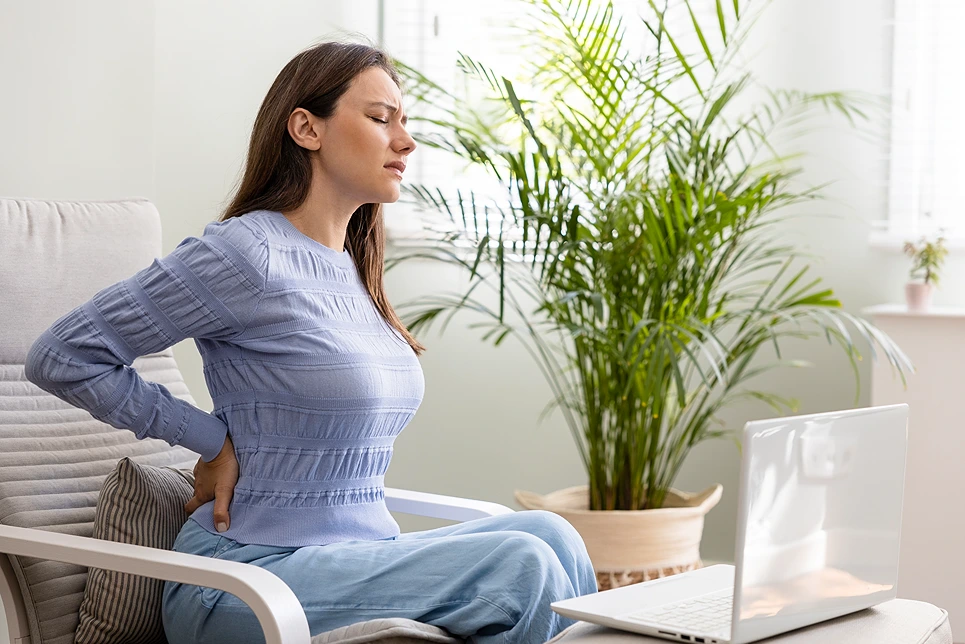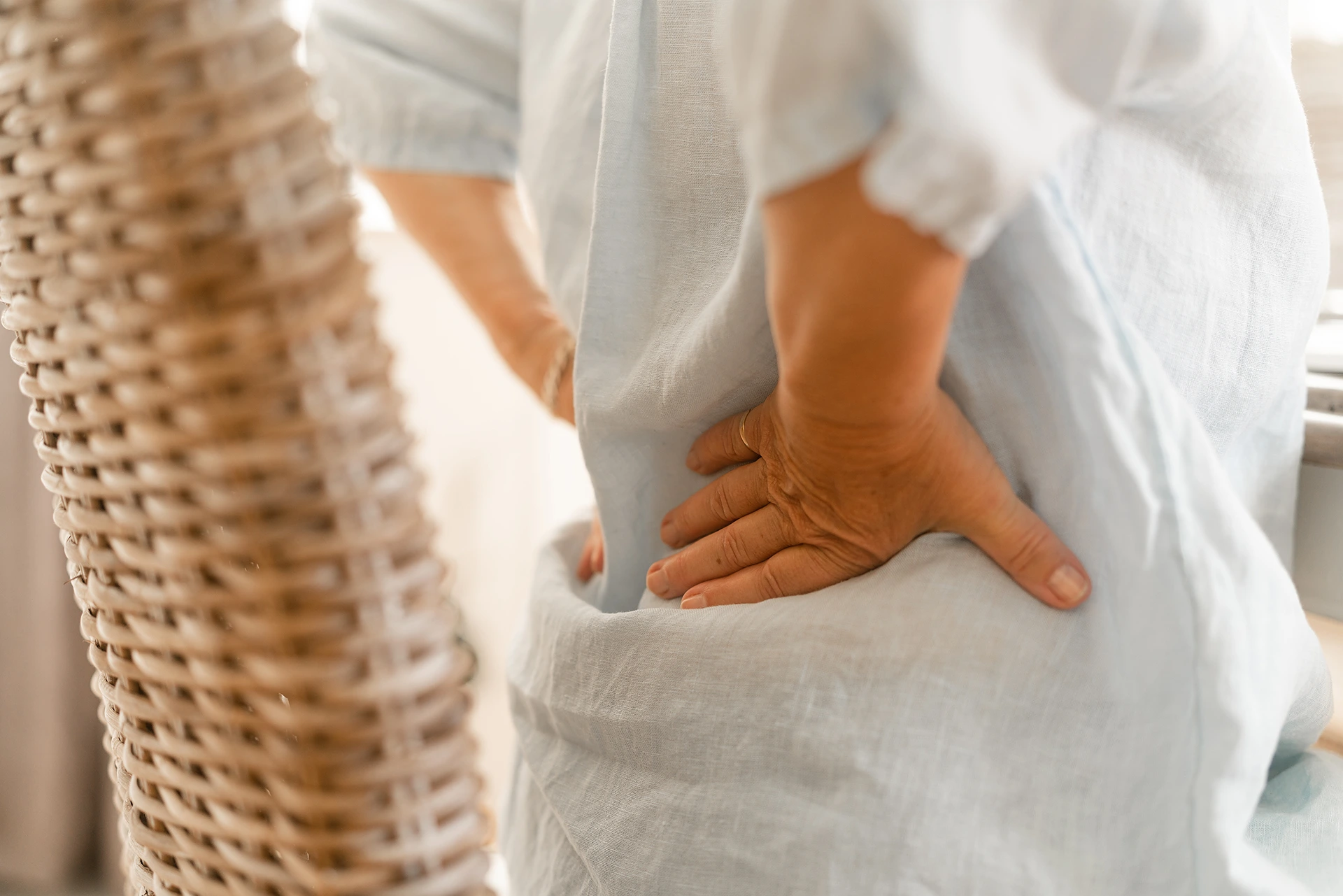Eighty percent of adults experience lower back pain at some point in their lives.
If you’re currently one of them, then you know how much the pain can disrupt your daily life.
While a dull ache or sudden twinge can be annoying, severe or recurrent back muscle pain can make it difficult to carry out normal activities.
What Causes Lower Back Muscle Pain?
Your lower back supports the weight of your upper body and allows you to move, bend, and twist. This area of the spine called the lumbar region bears the brunt of mechanical stress and strain. Problems with muscles, tendons, ligaments, discs, joints and nerves in this region can lead to lower back muscle pain. Some common causes include:
Muscle Strains and Sprains
Muscle strains and sprains are a leading cause of acute lower back pain. A muscle strain refers to torn muscle fibers or tendons, often from overuse or improper lifting. Repeated heavy lifting, sudden awkward movements, sports injuries, or even sneezing can overstretch muscles and cause painful spasms.
Lumbar Spine Conditions
Wear-and-tear on structures of the lumbar spine such as discs, facet joints and vertebrae can result in degenerative conditions like disc degeneration, arthritis, spondylosis, and spinal stenosis. These lead to chronic lower back pain and stiffness that worsens with activity. Aging, obesity, and genetic factors contribute to these degenerative spinal changes.
Sciatica
Sciatica refers to compression or irritation of the sciatic nerve which runs from the lower back down the legs. A herniated disc, bone spur, or narrowing of the spine (spinal stenosis) can pinch this nerve, causing shooting leg pain. The low back pain from sciatica is typically accompanied by numbness, tingling, or weakness in the leg or foot on the affected side.
Poor Posture and Ergonomics
Sitting or standing with poor posture for extended periods stresses the muscles, ligaments and discs of the lower back. Slouching and leaning forward head puts extra strain on back muscles and supportive structures. Using improper ergonomics at your workstation or while driving also contributes to back muscle problems over time.
Lack of Exercise
Weak core muscles in the back and abdomen from lack of regular exercise allows excessive movement and strain on the lumbar spine. Weak gluteal and hip muscles also fail to properly support and stabilize the pelvis and low back when standing or moving. This can lead to injury and pain.
Being Overweight
Carrying excess body weight, especially around the abdomen, puts added stress on the muscles, joints and discs of the lower back. This extra burden combined with weak core muscles is a recipe for lower back muscle strains and disc herniation. Excess weight can accelerate spinal disc degeneration and arthritis.
What Symptoms May Occur with Lower Back Muscle Pain?
Lower back muscle pain symptoms can range from mild to excruciating depending on the underlying cause. Typical symptoms include:
- Aching, stiffness or tightness in the low back muscles
- A sudden sharp “catch” in the back when bending, twisting or lifting
- Pain that worsens when standing, sitting or arching the back
- Muscle spasms causing severe lower back pain
- Radiating pain into the buttocks, thighs or legs
- Numbness, tingling or weakness extending down the leg (sciatica)
- Reduced range of motion – difficulty bending, walking or finding a comfortable position
- Muscle weakness making it hard to lift the legs when lying on your back
The pain may be localized in one spot or diffuse across the lower back area. Muscle pain is often described as tight, stiff, or throbbing. The severity can range from mild soreness to an intense stabbing or “locked up” feeling.
Episodes may last a few days or persist for weeks or months if underlying causes like disc problems go unaddressed.
When Should I See a Doctor About Lower Back Muscle Pain?
Mild to moderate back muscle pain often resolves with rest, over-the-counter medications and home treatment. But you should make an appointment with your doctor if:
- Intense or debilitating pain lasts more than 1-2 weeks
- You have difficulty walking or performing daily activities
- You experience numbness, tingling or weakness in a leg or foot
- You have a history of spinal conditions or cancer
- You have pain at night plus unexplained weight loss or fever
- You have pain, numbness or tingling after a back injury
Red flags like difficulty moving, leg weakness, or bladder/bowel dysfunction can indicate a serious underlying problem requiring urgent medical care.
What Diagnostic Tests Help Evaluate Lower Back Muscle Pain?

A physician will begin with a medical history and physical exam of your back to assess muscle tenderness, range of motion, gait, reflexes and nerve function. They may order certain tests to aid diagnosis:
Some of these tests may include:
| Diagnostic Test | Description |
| Imaging – X-rays, CT scans, MRI | Can reveal spinal alignment issues, bone spurs, disc bulges, tumors, fractures, and malformations. MRI best shows disc, nerve and muscle problems. |
| Electromyography | Records electrical signals in muscles to check for nerve compression or muscle disorders. |
| Bone Scan | Checks for spinal tumors, infections and inflammatory arthritis. |
| Lab Tests | Evaluate for autoimmune arthritis, infections, and conditions affecting bone density and nerves. |
| Diagnostic Injections | Diagnostic Injections |
The results help determine underlying causes like disc herniation, spinal stenosis, infections, or nerve impingement to guide appropriate treatment.
What Treatments and Home Remedies Help Relieve Lower Back Muscle Pain?
Most lower back muscle pain improves within 4 to 6 weeks using conservative at-home treatments combined with light activity modification. Options to alleviate pain and promote healing include:
OTC Pain Medication
Anti-inflammatories like ibuprofen or naproxen sodium reduce swelling and pain. Acetaminophen helps relieve soreness but doesn’t reduce inflammation. Topical pain creams applied to the low back can also provide relief.
Heat and Ice Therapy
Applying heating pads or hot packs helps relax tense back muscles and increase blood flow. Cold compresses or ice packs reduce inflammation and swelling. Alternate heat and ice for best results.
Exercise and Stretching
Specific back stretches and light strengthening exercises help improve flexibility and support the lower back. Core-strengthening moves like planks and pelvic tilts build abdominal and back muscles.
Proper Lifting Mechanics
Use your legs to lift objects, keeping your back straight. Avoid lifting and twisting simultaneously which strains muscles. Limit overhead lifting.
Massage Therapy
Massage loosens tight muscle fibers and reduces painful spasms. A licensed therapist can target trigger points and use techniques like myofascial release.
Spinal Manipulation
Chiropractors perform adjustments to realign the vertebrae and restore mobility of the spinal joints and muscles. Evidence supports short-term pain relief.
Posture Correction
Using lumbar support cushions and ergonomic chairs improves posture when sitting. Be mindful of posture and back positioning throughout the day.
Lifestyle Changes
Loss of excess weight reduces load and strain on the lumbar spine. Stress management and proper sleep also help decrease muscle tension.
Surgery
If conservative measures fail, options like disc repair, spinal fusion or laminectomy may be considered for debilitating back problems.
Your doctor can help develop a tailored treatment plan based on examination findings and test results. Physical therapy, steroid injections, nerve block procedures, braces, and TENS unit may also be incorporated for pain relief.
Get Professional Help For Your Lower Back Muscle Pain
Lower back muscle pain can significantly disrupt your daily life. And understanding its potential causes, symptoms, and treatment options is key to finding relief.
While home remedies like heat/ice therapy, OTC medication, and gentle stretches can help manage mild cases, it’s important to see a doctor for severe, recurring, or worsening pain. They can properly diagnose and treat any underlying spinal conditions through imaging, lab tests, injections, medication, physical therapy, or possibly surgery.
Finding the right doctor who specializes in back pain is critical for getting an accurate diagnosis and effective treatment plan. Kaly makes it easy to connect to top-rated local back pain specialists based on your unique symptoms and needs.
Kaly matches patients to providers through a simple Q&A process and uses patented algorithms to analyze doctors’ expertise, verified patient reviews, accepted insurance, and other key factors. This streamlines the search so you can quickly schedule with the right spine specialist or pain management doctor.
Let Kaly help you take control of your back pain and improve your quality of life now.
